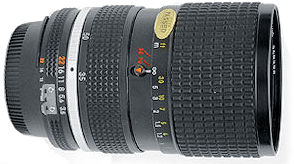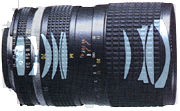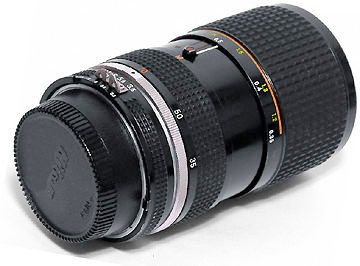During the mid-eighties, many camera manufacturers began to bundle entry level SLR with a compact zoom to replace the traditional method of supplying with a 50mm standard lense, hence 35-70mm zoom lenses with a moderate 62°~34°20' angle of view were often called "standard zooms". Although the zoom range falls short of everything, but such lens type was immensely popular those days as it replaces three popular fixed focal length lenses at 35mm, 50mm and 70mm. One of its main advantage offers is flexibility in picture framing. The angle of view increases and perspective becomes increasingly stretched out when zooming back from the standard 50mm focal length towards the 35mm end.
 |
As you zoom from the 50 mm setting to the 70mm extremity, you will notice that blurs, rather than compressed perspective, become increasingly conspicuous. Zooming capability thus permits optimal framing, plus the choice of elongated or compressed perspective to suit the subject. |
Although there was no indication
Nikon decided this was aimed directly to replace the commercially very successful
Zoom-Nikkor
43-86mm f/3.5 lens,
but it many ways, it has proven later 35mm wideangle for a zoom lense is more practical
for photographers than 43mm. However, despite 35-70mm zoom lenses were getting momentum
in its popularity, the 43-86mm lens did held very well in its position within the
Nikkor lens family until 1981before it was officially being discontinued. Over the
years, in relation to MF Nikkor/Nikon zoom at/near these specific focal lengths,
there were a Zoom-Nikkor 35-70 mm f/3.5, Zoom-Nikkor 35-70 mm f/3.5s MACRO,
Nikon
Series E 36-72mm f/3.5s,
Ai-S
Zoom-Nikkor 35-70mm f/3.3~4.5s
being introduced by Nikon thus far. Each of these versions has varying degree of
lens specifications, maximum aperture, design, construction and unfortunately, performance
as well. Huh ? Well, below was a mail from John Owlett, Southampton which was sent
to me quite a while ago, but I did tell him I may have to use the content in his
mail for some explanation one day - of which I am doing right now, hehe ... (come
to think of it, I am quite a lazy guy... anyway, John writes better English than
me, ain't that reason alone is good enough?).
Original
version of the 35-70mm
f/3.5
Zoom-Nikkor (with 72mm filter attachment
size)
 Credit: Please contribute some high quality original images of this version (72mm attachment size) to this website. |
This two-lens-groups design Nikkor wide to short tele zoom was first announced during Pre-Ai period at Photokina 1976. Although generally most users would believe this zoom was eventually released with only an Ai outfit and there wasn't a Non-Ai lense being produced thus far. Some collectors may have differing opinions relating to this comment but I really loved to see a Non-Ai version of this zoom lense surfaced to clear this long pending doubt. Next literally unresolved question that kept lingering in my mind was the contradictory reports which often claimed the Ai-S version of this zoom lense were still being sold until late in 1987 but I couldn't find any conclusive evidence as from the many official Nikon Sales Manuals over these years, they have only stated one version that remained in their production - the 62mm filter sized Ai Zoom-Nikkor 35-70mm f/3.5 MACRO version. |
The 72mm attachment size version of the Zoom-Nikkor 35-70mm f/3.5 has not been mentioned at all in all these journals. However, as Nikon may practiced a different marketing strategies so, I don't entirely write off possibilities that they might have been sold this lense along with the MACRO version of this 35-70mm zoom. Some reference books even stated there was an Ai-S version of this lense which bears S/N from 821001 which started marketing in 1981. If you have such a version of this lense, please help to send me some images (appropriate credit will be given for such contributing effort). Thanks. |
|
 |
 |
Those days, it was considered as an exciting addition to the wideangle Zoom-Nikkor lens lineup which comprised of only the earlier 43-86 and 28-45 zooms, the 35-70mm f/3.5 combines the wideangle, normal and medium telephoto capabilities in one unit to create a zoom lens that is equally at home in general photography, sports and press-journalism. The interesting technical highlight of this zoom lense was in its ability to successfully overcoming distortion problems that once prevented the development of sharp zoom lenses covering the focal length of this range, this Zoom-Nikkor delivers sharp, high quality images that are quite competitive with those of fixed focal length lenses. This version of the 35-70mm Nikkor zoom lens focuses down to 1 meter and accepts 72mm accessories which combines with its 10 elements in 9 groups design that contributes to its considerably heavy half-a-kilo (550g) weight. |
Other technical
highlight includes a useful Zoom coverage ranging from 62° wideangle to 34°
20' moderate telephoto. It uses separate zoom and focusing rings for independent
control. It has a larger 72mm filter attachment size where it was supplied with a
72mm screw in front lens cap and hard lens case. Photographic uses include photojournalism,
sports, travel, backpacking, environmental portraiture, annual report work, scenic,
candids of people, weddings, electronic flash shooting, group shots, full-length
as well as head-and shoulders portraits in the studio or on location, and zoom blurs.
An interesting feature of this general purpose zoom lense is, it provides a continuous
zooming at the same focus. Overall, it is a good substitute for wideangle and/or
standard lense whenever large aperture for shooting low available light is not necessary
Specifications:
Focal length/Aperture: 35 -70mm f/3.5 Lens construction: 10 elements in
9 groups
Picture angle: 62° - 34°20' Diaphragm: Automatic
 |
Aperture scale: f/3.5 ~ f/22 on both standard and aperture-direct-readout scale |
 |
|
Zoom-Nikkor 35-70mm f/3.5s MACRO (with 62mm filter attachment size)
 |
The next upgrade of this popular Nikkor zoom occurred in 1981. Other than employing a similar optical construction in 10 elements in 9 groups, weighs lighter at 510g and has a smaller filter attachment size at 62mm instead of 72mm, which leads many users regard the next version with MACRO/close focus capability as an update but the new lense has an entirely different optical arrangement of lens composition as well as in its overall performance, in particularly with its close focus capability that excels the predecessor. Thus, I would rather refer this zoom lense as an new designed 35-70 zoom rather than just a update. |
The built-in macrofocus capability which allows it to be focused down to 1.1 ft. (0.35m), at this range, the lense provides 1:4 reproduction at 70mm setting. A tiny button locates at the lens barrel allow locking in the macrofocus "M" setting. This version can easily be distinguished from the earlier version via a striking orange-colored engraved stripe to indicate the close-up range. Although both versions of the 35-70 employed a similar dual rings design and have same number of lens elements, but the macro version has a different displacement of the lens elements during the change between wide-angle and telephoto settings.
 |
Obviously this lense was a fruit of the research by computer simulations, the movement of the zooming system was reduced by dividing the rear lens group into two separate subgroups, one which moves and one which doesn't. Further, macro photography is possible at the 70mm end at the short film to-subject distance of 35cm which permits more natural perspective than using 35mm setting. Despite embodies a more complex design, Nikon optical engineers still be able to retain a constant f/3.5 speed throughout the focal length range. |
Focal length/Aperture: 35 -70mm f/3.5s
Lens construction: 10 elements in 9 groups Picture angle: 62° - 34°20' Diaphragm: Automatic
Aperture scale: f/3.5 ~ f/22 on both standard and aperture-direct-readout scale (note: at f/4.0 only a click stop is provided).
 Attachment size: 62mm (P = 0.75); Weight: 520g Dimensions: 66.5mm dia. x 105mm long (overall); 96.5mm extension from flange; Filters:62mm front screw-in; Front lens cap: Screw-in Lens hood: HN-22 screw-in type; Lens case: CL-33S hard leatherette; No. 62 soft pouch or CP-9 Plastic; Usable Teleconverter(s): TC-200 | TC-201 | TC-14A |
Focusing and zooming control: via two separate rings |
Credit: An excellently captured image of this lense was contributed by a seasoned Ebay seller Mr JOE "Cronos" <southtexasphoto@prodigy.net>. Image copyright © 2003 All rights reserved. |
 |
Most users would not disagree with me if I quote this superbly crafted Nikkor zoom lense was easily the best MF Nikkor performer offered at the 35-70mm range. Along with the Zoom-Nikkor 80-200mm f/4.0s that was introduced later in August, 1981 both lenses have enjoyed rave reviews as the premium quality MF Nikkor zoom lenses to covers useful zoom range from 35mm -200mm. |
However, the ever changing market place at the time has cornered Nikon with an embarrassing position as most other camera manufacturers (as well as third party lens makers) were already started offering many cheap, affordable versions of zoom lenses with equally practical zoom range to question Nikon's call for justification to ask such a high premium over their two zooms. The fast speed MF Zoom-Nikkor 80-200 f/2.8s ED that was being introduced a year later in December, 1982 may has a better reason to command a higher premium but undeniably both of the zoom lenses have been excessively priced in comparison to make Nikon faced a tough task to provide an affordable zoom lense for entry level 35mm SLR users.
 |
| Previous | NEXT | The next section covers versions of MF Zoom-Nikkor 35-70mm f/3.3~4.5s and MF Zoom-Nikkor 35-70mm f/3.5~4.8s 1/2 |
| Message Board |
for
your Nikkor
Optics
in a shared environment
| Message
Board
| Specifically for Dispose or Looking for new/used Nikon/Nikkor
photographic equipment
| Nippon Kogaku Rangefinder Resources | Nikon F | Nikon F2 | Nikon F3 | Nikon F4 | Nikon F5 | Nikon F6 | Nikkormat / Nikomat | Nikon FM Series | Nikon FE/ FA | Nikon EM/FG/FG20 | Nikon Digital SLRs | Nikon - Other models |
Nikon MF RF-Nikkor lenses for Rangefinder
cameras:-
Main Index Page
Nikon
Auto Focus Nikkor lenses:- Main
Index Page
Nikon
Manual
Focus
Nikkor lenses:-
Fisheye-Nikkor Lenses - Circular |
Full Frame |
Ultrawides Lenses - 13mm15mm18mm20mm |
Wideangle Lenses - 24mm28mm35mm |
Standard Lenses - 45mm 50mm 58mm | Telephoto Lenses
- 85mm105mm135mm180mm & 200mm |
Super-Telephoto Lenses - 300mm 400mm 500mm 600mm 800mm 1200mm |
 |
Special Application
lenses: Micro-Nikkor Lenses - 50mm~55mm -60mm 85mm -105mm 200mm Micro-Zoom 70-180mm Perspective Control (PC) - 28mm 35mm PC-Micro 85mm Dedicated Lenses for Nikon F3AF: AF 80mm f/2.8 | AF 200mm f/3.5 EDIF Depth of Field Control (DC): 105mm 135mm Medical Nikkor: 120mm 200mm Reflex-Nikkor Lenses - 500mm 1000mm 2000mm Others: Noct Nikkor | OP-Nikkor | UV Nikkor 55mm 105mm | Focusing Units | Bellows-Nikkor 105mm 135mm Nikon Series E Lenses: 28mm35mm50mm100mm135mm | E-Series Zoom lenses: 36~72mm75~150mm70~210mm |
MF Zoom-Nikkor Lenses: 25~50mm | 28~45mm | 28~50mm | 28~85mm | 35~70mm | 36~72mm E | 35~85mm | 35~105mm | 35~135mm | 35~200mm | 43~86mm | 50~135mm | 50~300mm | 70~210mm E | 75~150mm E | 80~200mm | 85~250mm | 100~300mm | 180~600mm | 200~400mm | 200~600mm | 360~1200mm | 1200~1700mm
Tele-Converters: TC-1 | TC-2 | TC-200 | TC-201 | TC-300 | TC-301 | TC-14 | TC-14A | TC-14B | TC-14C | TC-14E | TC-16 | TC-16A | TC-20E
Recommended links to understand more technical details
related to the Nikkor F-mount and production Serial Number:
http://rick_oleson.tripod.com/index-153.html by: my
friend, Rick Oleson
http://www.zi.ku.dk/personal/lhhansen/photo/fmount.htm by: Hansen,
Lars Holst
http://www.mir.com.my/rb/photography/hardwares/nikonfmount/lens2.htm
http://www.photosynthesis.co.nz/nikon/serialno.html
Recommended Reading Reference on Nikon cameras and Nikkor lenses | about this photographic web site
| | Back | Main Index Page of Nikkor Resources | Back | Main Index Page of Pictorial History of Nikon SLRs |
| Home - Photography in Malaysia |
![]() Co-developed
with my web buddy, Rick Oleson® &
Co-developed
with my web buddy, Rick Oleson® & ![]() Denmark, Creator of the Nikon
Repair Group Mailing-List;
A
contributing effort to Michael Liu's Classic Nikon SLRs and
Nikkor optic site.
Denmark, Creator of the Nikon
Repair Group Mailing-List;
A
contributing effort to Michael Liu's Classic Nikon SLRs and
Nikkor optic site.
Credit: MCLau®, who has helped to rewrite
some of the content appeared this site. Chuck Hester® who has been helping
me all along with the development of all these Nikon websites; Lars Holst Hansen, 'Hawkeye'
who shares the same passion I have; Ms Rissa, Sales manager
from Nikon Corporation Malaysia for granting permission to use some of the official
content; Ted Wengelaar, Holland
who
has helped to provide many useful input relating to older Nikkor lenses; Some of the references
on production serial numbers used in this site were extracted from Roland Vink's website; Hiura Shinsaku from Nikomat
Club Japan. Lastly,
to all the good people who has contributed their own expeience, resources or kind
enough granted permission to use their images of their respective optic in this site.
It is also a site to remember a long
lost friend
on the Net. Note:certain content and
images appeared in this site were either scanned from official marketing leaflets
& brochures published by Nikon and/or contribution from surfers who claimed originality
of their work for educational purposes. The creator of the site will not be responsible
for may discrepancies arise from such dispute except rectifying them after verification. "Nikon", "Nikkormat", "Nippon Kokagu
KK"
& "Nikkor" are registered
tradename of Nikon Corporation Inc., Japan. Site made with an Apple IMac.